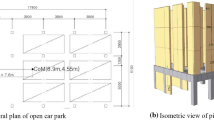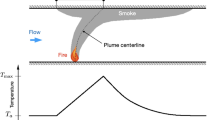Abstract
The paper presents numerical simulations of a fire in the Howard Street Tunnel, Baltimore, Maryland, following the derailment of a freight train in July, 2001. The model was validated for this application using temperature data collected during a series of fire experiments conducted in a decommissioned highway tunnel in West Virginia. The peak predicted temperatures within the Howard Street Tunnel were approximately 1,000°C (1,800°F) within the flaming regions, and approximately 500°C (900°F) averaged over a length of the tunnel equal to about four rail cars.
Similar content being viewed by others
References
NTSB Fire Group—Factual Report, NTSB Public Docket, Report Issue Date: October 2002. NTSB Case Reference Number: DCA 01 MR 004; Accident Site Location Reference: Baltimore, Maryland (Howard Street Tunnel); Accident Date Reference: July 18, 2001.
H.E. Adkins and J.M. Cuta, “Components Exposed to a Tunnel Fire Environment.” NUREG/CR-6799, Pacific Northwest National Laboratory, Richland, Washington, March 2003. Work performed under contract to the US Nuclear Regulatory Agency, Washington DC.
K.B. McGrattan (Ed.), “Fire Dynamics Simulator (Version 4), Technical Reference Guide,” NIST Special Publication 1018, National Institute of Standards and Technology, Gaithersburg, Maryland, July 2004.
Memorial Tunnel Fire Ventilation Test Program. Interactive CD-ROM and Comprehensive Test Report, Massachusetts Highway Department, 1996.
K.B. McGrattan and A. Hamins, “Numerical Simulation of the Howard Street Tunnel Fire,” Baltimore, Maryland, July 2001. NISTIR 6902, National Institute of Standards and Technology, Gaithersburg, Maryland, January 2003. Joint Publication of NIST and the US Nuclear Regulatory Commission (NUREG/CR-6793).
F.P. Incropera and D.P. De Witt, Fundamentals of Heat and Mass Transfer (4th edition). John Wiley and Sons, New York, 1996.
V. Babrauskas, SFPE Handbook of Fire Protection Engineering (3rd edition), Chapter Heat Release Rates. National Fire Protection Association, Quincy, Massachusetts, 2002.
J. Quintiere, “A Perspective on Compartment Fire Growth,” Combustion Science and Technology, vol. 39, 1984, pp. 11–54.
M.A. Kramer, M. Greiner, and J.A. Koski, “Radiation Heat Transfer to the Leeward Side of a Massive Object Suspended over a Pool Fire,” in Proceedings of 2001 ASME International Mechanical Engineering Congress and Exposition, American Society of Mechanical Engineering, November 2001. IMECE2001/HTD-24250.
J.G. Quintiere, Principles of Fire Behavior. Delmar Publishers, Albany, New York, 1998.
Author information
Authors and Affiliations
Rights and permissions
About this article
Cite this article
McGrattan, K., Hamins, A. Numerical Simulation of the Howard Street Tunnel Fire. Fire Technol 42, 273–281 (2006). https://doi.org/10.1007/s10694-006-7506-9
Published:
Issue Date:
DOI: https://doi.org/10.1007/s10694-006-7506-9




